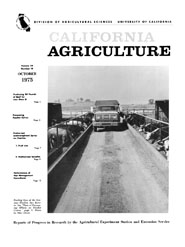


University of California
California Agriculture
|
|||
|
|||

Cover:
Feeding time at the Norman Feedlot, San Jacinto. See “Time of Processing
Effects on Feedlot Calves,” - Photo by Max Clover.
October 1975
Volume 29, Number 10 News and opinion |
|||
|
University of California, 1301 S. 46th St., Bldg. 478 Richmond, CA
|